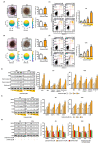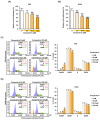Disruption of Endoplasmic Reticulum and ROS Production in Human Ovarian Cancer by Campesterol
- PMID: 33802602
- PMCID: PMC8001332
- DOI: 10.3390/antiox10030379
Disruption of Endoplasmic Reticulum and ROS Production in Human Ovarian Cancer by Campesterol
Abstract
Phytosterols, which are present in a variety of foods, exhibit various physiological functions and do not have any side effects. Here, we attempted to identify functional role of campesterol in regulation of oxidative stress by leading to cell death of ovarian cancer. We investigated the effects of campesterol on cancer cell aggregation using a three-dimensional (3D) culture of human ovarian cancer cells. The effects of campesterol on apoptosis, protein expression, proliferation, the cell cycle, and the migration of these cells were determined to unravel the underlying mechanism. We also investigated whether campesterol regulates mitochondrial function, the generation of reactive oxygen species (ROS), and calcium concentrations. Our results show that campesterol activates cell death signals and cell death in human ovarian cancer cells. Excessive calcium levels and ROS production were induced by campesterol in the two selected ovarian cancer cell lines. Moreover, campesterol suppressed cell proliferation, cell cycle progression, and cell aggregation in ovarian cancer cells. Campesterol also enhanced the anticancer effects of conventional anticancer agents. The present study shows that campesterol can be used as a novel anticancer drug for human ovarian cancer.
Keywords: ROS; campesterol; cell death; mitochondria dysfunction; ovarian cancer.
Conflict of interest statement
The authors declare no conflict of interest.
Figures








Similar articles
-
ER-Mitochondria Calcium Flux by β-Sitosterol Promotes Cell Death in Ovarian Cancer.Antioxidants (Basel). 2021 Oct 8;10(10):1583. doi: 10.3390/antiox10101583. Antioxidants (Basel). 2021. PMID: 34679718 Free PMC article.
-
Stigmasterol Causes Ovarian Cancer Cell Apoptosis by Inducing Endoplasmic Reticulum and Mitochondrial Dysfunction.Pharmaceutics. 2020 May 28;12(6):488. doi: 10.3390/pharmaceutics12060488. Pharmaceutics. 2020. PMID: 32481565 Free PMC article.
-
Morusin induces paraptosis-like cell death through mitochondrial calcium overload and dysfunction in epithelial ovarian cancer.Chem Biol Interact. 2018 Mar 1;283:59-74. doi: 10.1016/j.cbi.2018.02.003. Epub 2018 Feb 5. Chem Biol Interact. 2018. PMID: 29421517
-
Oxidative stress and protein aggregation during biological aging.Exp Gerontol. 2001 Sep;36(9):1539-50. doi: 10.1016/s0531-5565(01)00139-5. Exp Gerontol. 2001. PMID: 11525876 Review.
-
Activation of apoptosis signalling pathways by reactive oxygen species.Biochim Biophys Acta. 2016 Dec;1863(12):2977-2992. doi: 10.1016/j.bbamcr.2016.09.012. Epub 2016 Sep 17. Biochim Biophys Acta. 2016. PMID: 27646922 Review.
Cited by
-
Sterols in Inflammatory Diseases: Implications and Clinical Utility.Adv Exp Med Biol. 2024;1440:261-275. doi: 10.1007/978-3-031-43883-7_13. Adv Exp Med Biol. 2024. PMID: 38036884 Review.
-
Selected Seeds as Sources of Bioactive Compounds with Diverse Biological Activities.Nutrients. 2022 Dec 30;15(1):187. doi: 10.3390/nu15010187. Nutrients. 2022. PMID: 36615843 Free PMC article. Review.
-
Cytotoxicity against A549 Human Lung Cancer Cell Line via the Mitochondrial Membrane Potential and Nuclear Condensation Effects of Nepeta paulsenii Briq., a Perennial Herb.Molecules. 2023 Mar 20;28(6):2812. doi: 10.3390/molecules28062812. Molecules. 2023. PMID: 36985784 Free PMC article.
-
Assessing the cytotoxicity of phenolic and terpene fractions extracted from Iraqi Prunus arabica against AMJ13 and SK-GT-4 human cancer cell lines.F1000Res. 2024 Sep 10;12:433. doi: 10.12688/f1000research.131336.3. eCollection 2023. F1000Res. 2024. PMID: 39416710 Free PMC article.
-
ER-Mitochondria Calcium Flux by β-Sitosterol Promotes Cell Death in Ovarian Cancer.Antioxidants (Basel). 2021 Oct 8;10(10):1583. doi: 10.3390/antiox10101583. Antioxidants (Basel). 2021. PMID: 34679718 Free PMC article.
References
-
- Genser B., Silbernagel G., De Backer G., Bruckert E., Carmena R., Chapman M.J., Deanfield J., Descamps O.S., Rietzschel E.R., Dias K.C., et al. Plant sterols and cardiovascular disease: A systematic review and meta-analysis†. Eur. Hear. J. 2012;33:444–451. doi: 10.1093/eurheartj/ehr441. - DOI - PMC - PubMed
Grants and funding
LinkOut - more resources
Full Text Sources
Other Literature Sources

